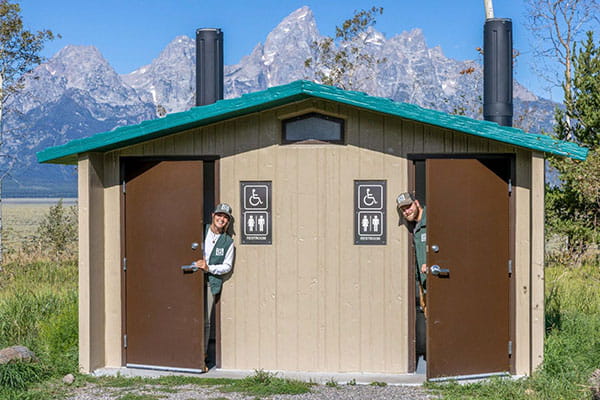The Bridger-Teton National Forest near Jackson, Wyo., contains more than 3.4 million acres of stunning wildlands as part of the Greater Yellowstone Ecosystem. Home to 74 species of mammals, 355 species of birds, and six species of reptiles, it was also home to Matt Sweitzer ’16 for three months last summer. Living off the grid with his fiancée, Julia, the pair volunteered as Wilderness Ambassadors, educating visitors on appropriate ways to interact with the ecosystems around them during the summer of 2023.
An Eagle Scout who grew up on a 300-acre tree farm in Western Massachusetts, Sweitzer developed an appreciation for nature early. After graduating from Endicott in 2016, he and his now-fiancée set out on a four-month RV trip to 35 National Parks, including Yellowstone and Grand Teton in Wyoming.
“I just fell in love with the Park Service and with the land that they’re protecting,” Sweitzer shared. “I decided I needed to start doing anything I can to protect the ecosystems out there.”
When Sweitzer returned from this life-changing trip, he turned an interest in clean technology and clean energy into a job with Greentown Labs, one of the world’s largest incubators for cleantech startups. He later took a position with Boston Engineering, which was then acquired by PDSVISION, a digital transformation company that helps organizations and product developers package data for large-scale manufacturing.
Now the U.S. Services Manager for the company, Sweitzer put his entrepreneurial training from his undergraduate degree in business administration to use and created a unique proposition for a working sabbatical—PDSVISION would sponsor Sweitzer and Julia as they lived and volunteered as stewards of the U.S. National Forest.

Good old-fashioned environmental project work
Sweitzer says his naturalist philosophy has changed a bit over the years.
One of his internship roles while at Endicott was in the Colin and Erika Angle Center for Entrepreneurship, where Sweitzer helped students write business plans and apply for funding as a manager of field programs.
“That startup mentality helped me focus on what I can do to help individuals,” explained Sweitzer. “I became more of a micro thinker, focusing on small organizations and seeing if I can make maximum impact. And that same mentality helped me go out and decide to help a specific area of land rather than trying to solve the whole world’s problems at once.”
Sweitzer’s position at Greentown Labs, which he landed due to connections he made with the North Shore Technology Council when working on his senior thesis, brought him into contact with startups working in green tech on initiatives like carbon capture. His experiences in the space further honed his outlook on the best way to mitigate climate change.
“All I could think of was that we already had trees doing their part to capture carbon—so let’s stop cutting them down and protect what we already have,” Sweitzer shared. “A lot of companies are so focused on environmental impact on a macro level, with programs like switching to electric vehicles or reducing paper use. And that’s good, but I want to encourage a focus on what’s in our backyards.”
A great example to illustrate this, said Sweitzer, is the large Coca-Cola sponsorship sign you’ll see in the Old Faithful visitor’s center in Yellowstone National Park.
“Coke is giving millions of dollars to the national parks, which is awesome,” he explained. “But next to that sign, people are walking on the extremely fragile thermal bacteria beds. Giving more money is not going to mitigate that—what you need is boots on the ground to educate people on the damage they’re doing.”
A clear, visible impact on the land
Showing visitors how to best treat the land is exactly what Sweitzer and his fiancée did as Wilderness Ambassadors in Bridger-Teton National Forest. Tasked with helping the incredibly small number of Park Rangers assigned to care for millions of acres, they lived off-the-grid in a trailer and patrolled a 12-mile loop to check on campers.
“Our role was to reduce the human impact on wilderness,” said Sweitzer. “That included things like making sure everybody built fires inside the fire rings and put their fires out properly, or camped in specific campground spaces, and enforcing ‘leave no trace’ methodology. The most challenging of all was mitigating conflicts between humans and wildlife. People would walk right up to a bison herd to take pictures—the lack of education about the wilderness we saw was astounding. So that’s why we were there—to educate.”
With the wilderness at your front door (a moose once spent two hours in their campsite visiting) it’s easy to appreciate where you are, though leaving behind common amenities can take some getting used to.
“What’s interesting is you learn about what you need to survive and entertain yourself,” Sweitzer shared. “It’s surprising how much water you use doing dishes, or how little gasoline you need to run a few light bulbs. We didn’t have internet, but we had a tablet with our favorite movies and games downloaded. That’s great to have, but on the other hand, you don’t need that stuff, because you open the door and look at the mountains and they’re right there. Surrounded by coyotes, foxes, bears, bison, and moose … it’s breathtaking.”
What did Sweitzer miss the most? “Hot, running water,” he said with a laugh.
Sweitzer hopes to focus his passion and this experience on figuring out a way to help other organizations put together Parks Service trips like his for their employees.
“We were the youngest ambassadors in Bridger-Teton; the other folks were retired or pretty much done with their careers,” he explained. “So, I’d like to see how we can make this more attractive to young people. If we can somehow figure out a way to encourage more work trips from the corporate world, that’s really where I see a benefit.”
Read more about Sweitzer’s experience on the PDSVISION blog here and here.
